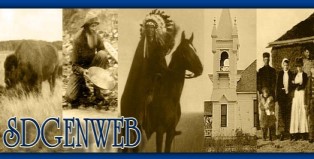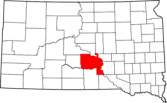|
Welcome to Lyman County SDGenWeb
|
Lyman County, South Dakota Genealogy Stories by Kathy Winter and Mrs. Hayes Written and submitted by Kathy Winter from her book, "Iona Heritage", published in 2006 in celebration of Iona’s Centennial. -------------------------------------------------------------------------------------------------------------------------------------- The Austin’s, Wilson’s, Knowles’, Roy’s, Ham’s and Dooley’s came to this area in 1890 followed in 1893 by Godagers, Lillie’s, Hacker’s; and in 1894 by Lou Anderson, Benedict, & Fenenga; people began to take up their homesteads, crossing the river by ferry. Ray Gooder built a store and dwelling on his land in the winter of 1897-98. This site was located two miles east and about ¾ miles north of the present site of Iona. A petition was circulated by residents for a post office, designating Gooder as Postmaster. The proposed name was “Terry”. The name “Iona” was selected by the Postal Department and the Iona Post Office was established February 11, 1898 and was closed November 5, 1983 The Condon store 3 miles west and one mile north was also started at about the same time. The residents of the area urged both stores be moved to a central location. Reuben Benedict owned the land where the present Iona is located and he offered to deed a plot sufficient for a town site. In 1901 the Condon store, operated by Wilcox; and the Iona Store operated by Gooder, were moved to the central location where Iona is now located. And so it all began! The Modern Woodmen of America started a camp at Iona, May 17, 1901, with J. M. Murphy in charge. This dissolved in 1922. A local Farmers Educational and Cooperative Union was also formed. For a few years farm supplies were purchases through this organization. L. G. Troth was chairman through February 1930. Only one meeting was recorded after that time. This article from the “Gregory Times Advocate” was received from Alvin Svoboda and Arlene (Svoboda) Parker and follows:
1919
Time Capsule Discovered in time for Iona
school reunion. Students of the Iona High School will be gathering this weekend for a class reunion, and the preparations for that event have un-earthed information from that community’s by-gone days. At the close of the second decade of this century, Frank A. Smith, a banker in Iona constructed a new bank building. The following information, accompanied by other documents, was sealed and deposited in a cornerstone of the building. This bank building later became a Lutheran Church and when the building was moved, the documents were found.
Sept. 14, 1919 The Farmers Cooperative Co. consisting of 31 members, manager Walter Rustimeyer, clerks Miss Gertrude Anderson and S.W. McDonald. Miss Anderson is also telephone operator. The other store is run by J. H. Kennedy, Miss Edna King and William Spaulding, clerks. Both stores carry large stocks of everything in the line of general merchandise, including machinery and auto trucks and buy all kinds of farmers produce, butter is forty cent per lb., eggs 30 cents per dozen, chickens 15 to 20 cents lb. Hogs that recently sold for $28 per hundred are now $14. Corn that was $1.90 per bushel is now about $1.50, wheat $1.20, rye $1.00, Barley .70, oats .75, cattle 6 to 11 cents per lb. The community is prosperous, autos common, many trucks and tractors, one hotel owned by P. L. Somers. One blacksmith shop owned by Freeman Suiter. One garage owned by Somers and Peterson. Also movies by Somers. One Methodist Church to the shame of the community they have no Pastor. One MW hall whose members have lost interest or have something like dry rot which has sapped the life of the organization. No schoolhouse but have a Petition out for the building of one. The county has in use and run by Jim Frank and Henry Zimmerman also George Ritter, one long grader which is doing good work and making good roads. L. G. Troth is county commissioner and directs their works. They have graded most roads from the Gregory County Line to White River and at work from the west and south. L. G. Troth is treasurer of the school board. William Frank is the chairman and P.L. Somers is clerk of the township board. George Kenzy, Irving Troth, Theron Nelson and Frank Smith of Oacoma are building a bank here. We will place this in the SW corner of the foundation with other documents. Mr. Briggs is the carpenter; J. D. Rose and sons, contractors. Fred Tagtow is building a nice $3,000 residence 3 miles east. Carl Tagtow has completed a fine barn 2 miles east and is putting in electric light in his residence and other outbuildings. Jake and Lynn Walker and their father shipped 3 cars of cattle and 1 of hogs to Sioux City recently. Harry Ham was taken to Mitchell recently where he had an operation performed. Mrs. P. L. Somers has returned from a visit to her sister in Nebraska. Emil Peterson returned from Colorado last Sunday. Theron Nelson and his wife have just completed an extended visit in Nebraska and Indiana. A man shot and killed a boy in a melon patch about a week ago. A disease called anthrax has been raging in Lyman County lately, killed lots of cattle for the farmers. L. B. Anderson lost a valuable horse caused by a wire wound. Arthur Salzmann’s little daughter broke her arm by a fall from a buggy. Mrs. John Hacker is in the hospital in Rochester, Minn. John H. Kennedy is the Postmaster. Percy Snort is the carrier to Dallas by Auto, Tom ??? to Oacoma, George Huffman is our rural carrier to Dixon. The boys who went overseas to the war have with few exceptions returned; Arthur Bunce having been the only man from here to have fallen in action. Carl Tagtow Jr., while joyriding with Gertrude Anderson and Cherry Rustimeyer and her escort had a breakdown causing them to walk in but the road was good and broad and they did not mind it. My mother, Martha E. McDonald, is 100 years old today and lives in Tennessee.” In 1939 the teacher, Mrs. Eliza (Hilmoe) Hayes and pupils of the Lincoln School, which was located three miles west and one mile south of Iona, published The Lincoln Journal. Mrs. Hayes must be given credit for the History of Iona; which is part of The Lincoln Journal, and has been published in the Lyman County Historical Society books and other publications. Inez (Nelson) Kenzy shared her copy. SEE: The LINCOLN JOURNAL in this book. Thank you, Eliza Hayes. In 1957 Lois Kenzy and May Fulwider were teachers at Iona and McKinley Schools. They were responsible for interviewing and writing stories of early pioneers who were still living in the Iona community at that time. They compiled a booklet which they called Pioneer Days and May shared it with me prior to her death. These stories have also been a part of other books. The book they made had a cover which was made out of plywood, and contained pictures of most of those that were interviewed. It had been left at the Iona School for all to enjoy, and a few of the stories were missing when May rescued it for preservation. SEE: PIONEER DAYS in this book. Thank you Lois Kenzy and May Fulwider! And now, an update about this place called Iona and the people who remain. In looking around the community it seems that it would be easier to count the newcomers to the community than those whose families have been here since the time Iona was first settled. Either way we remain a community of strong willed people. Those sons of the sons of the sons of pioneers keep finding just the right wife to bring to this special corner of the world. Very few women of the community have been here all of their lives. Being one of those whose family didn’t come to Iona until 1942 - it seems like it takes a lot of years to feel like you are “from” Iona, and really a part of what holds us together. Now, as another generation becomes the “older generation” we still have what is needed to keep the community a neighborhood. There just aren’t too many places like that left. We still know how to be a neighbor and to help in need. The Friendly Neighbors Club is still going strong and is a vital part of the community. It was started after WWII in 1949 by the second wave of imports from Texas, Indiana, Tennessee, as well as from the surrounding areas. At the time John Bond was keeping the cemetery records, and the cemetery was not being kept up; the Friendly Neighbors Club decided to make it their project. Several members literally walked around the cemetery and with the help of John Bond, Art Salzmann, May Meinen and Frances Lillie the unmarked graves were identified. It was at that time that the cemetery was mowed and cleaned up and the original white wooden crosses were added as markers for the unmarked graves. The Friendly Neighbors Club continues with the upkeep of the cemetery and improvements have been made through donations. With the introduction of automobiles, improved transportation and the completion of SD Highway 47 in 1958 the people of Iona became less dependent on local businesses. The Post Office survived until November 1983 and the last business – the Fulwider Store and Gasoline Station – closed in 1989. Space travel to the moon and beyond has been accomplished. The original Iona School opened in 1902 holding classes in several different buildings throughout the years. The first year of high school 1922-23 classes were held in the Methodist Church until the new school was finished. The high school offered a 3-year course which was continued through the 1944 term. A modern school was built in Iona in 1967-68 when consolidation was taking place as the one room schools no longer had enough students. The school remains open in this the final term 2005-2006 with 8 students. Homes have been modernized with all of the conveniences of city life. The South Dakota Rural Electric Association through Rural Electric Cooperatives, provided electricity to farms, homes, schools, and churches to most of rural South Dakota in 1952. In 1958 Northwestern Bell Telephone Company provided telephone service into Iona homes. Later, U.S. West was our provider and Golden West Communications purchased the Gregory exchange in 1997. Along with telephone service Golden West offered dial up Internet Service to this area for the first time. In 2005 the Gregory exchange (including Iona) became one of the first exchanges to have DSL (high speed internet) capabilities. The Tripp County Water Users District installed water lines and water was provided to our homes and farms in 1978. The American Agriculture Movement was born in the fall of 1977. Locally, farmers joined in protest of a new farm program that insured four more years of prices received for products below their cost of production. In 1979 the AAM organized a “tractorcade” to Washington, DC. Iona was well represented by Conrad “Nick” Salzmann and Diane Kenzy. AAM continues to be an organization of farmers who are the leaders, speakers and organizers. The last 50 years have brought a lot of changes in the way people make a living. Farms are much larger which seems to be a necessity for survival; the sad part is that when that happens, a neighbor has gone in the process. Several area farmers subsidize their farming operation with commercial pheasant hunting. This has become big business for this area. Lodges have been built where hunters can be housed and entertained. Birds are often planted and plentiful. It is a lucrative business for those that are willing to work hard. It isn’t unusual for a farmer’s wife to drive to town to work and in some cases the family lives in town and the farmer commutes to work on the farm. Our young people were again called to war from 1957 - 1975; the Vietnam War was the scene of 58,244 casualties. Their heroic contributions will never be forgotten, and their spirits live on in our hearts. Local Military Personnel listed as a Fallen Soldier of the Vietnam War was CPL Terry Howard Fenenga, son of Clifford and Gertrude Fenenga of Iona. Carson Bell and Bob Kenzy also served and have contributed to this book. Again in 2003 our troops were called to war, this time in Iraq. At 9:34 PM EST on March 19, 2003 (5:34 AM local time in Baghdad on March 20), the United States and United Kingdom forces began conducting military operations against the state of Iraq designed to disarm Iraq of its weapons of mass destruction and to remove the Iraqi Regime from power. President Bush addressed the American public stating that coalition forces were in the "early stages of military operations to disarm Iraq, to free its people and to defend the world from grave danger." Scott Drews, son of Charlie and Rita Drews served in Iraq with the 153rd National Guard Unit. Cale Cornemann, son of Dave & Alicia Cornemann, the grandson of Harold and Kathy Winter, is currently serving in Iraq with the 147th Field Artillery Brigade National Guard Unit out of Yankton. Jami Svoboda served with the Air Force and is now with the South Dakota Air National Guard out of Sioux Falls, SD. Joe Winter, son of Harold & Kathy Winter is serving as an Army Nurse, stationed in Colorado Springs, CO at this time. The war continues! -------------------------------------------------------------------------------------------------------------------------------------- Early
History of Iona As found in the Advocate Leader, Kennebec, SD, Dec. 28, 1939 issue I have had
the pleasure of interviewing a number of
the early pioneers of the Iona community
recently and it is with due |


